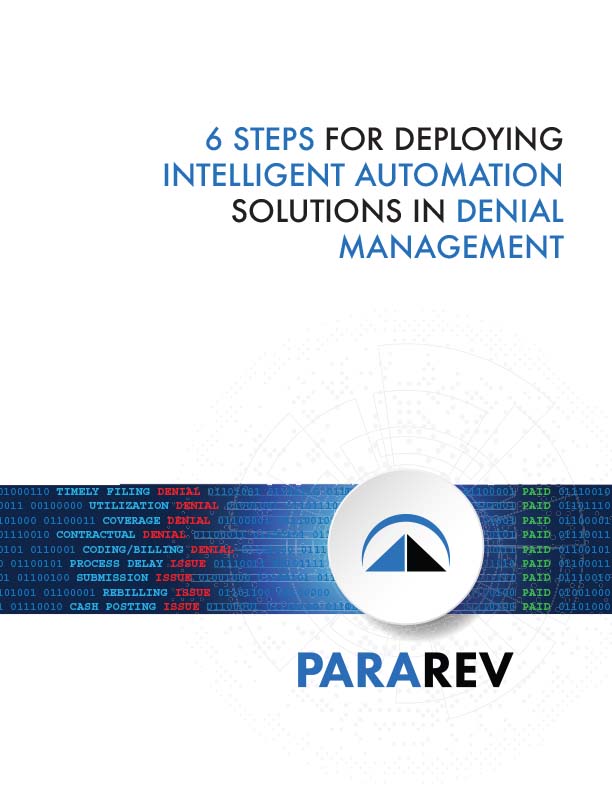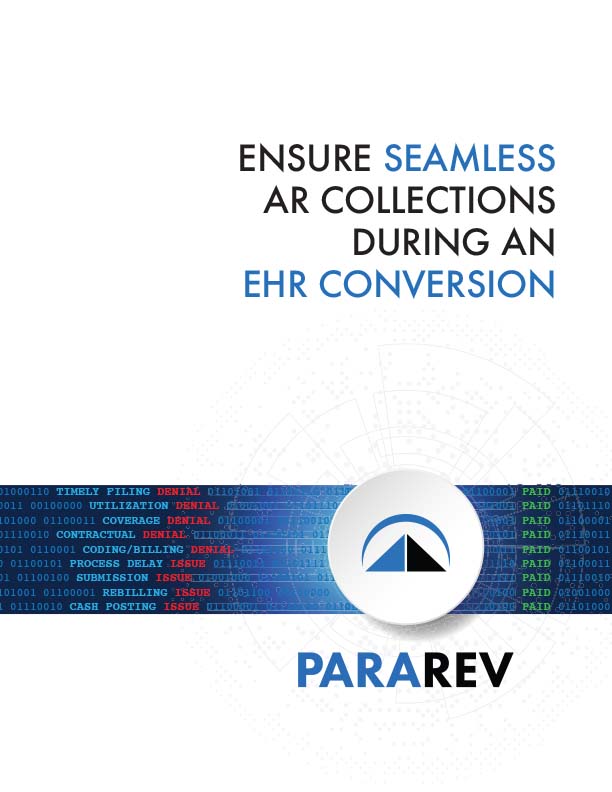Because hospital emergency departments (ED) serve as important gateways for inpatient admissions, it is essential that patient information, especially insurance data, is captured accurately at the time of service.
Unfortunately, the hectic pace and critical nature of ED services often means that confirming coverage takes a back seat to more pressing concerns. But with emergency volume rising and two-thirds of all admissions coming through the ED,[1] hospitals risk growing denials and write-offs if they can’t effectively collect payment information at the outset of the care event.
Mistakes or omissions that occur during the initial encounter affect not only payment for emergent services, but also can flow downstream to impact reimbursement opportunities along the entire continuum of care.
ED denial causes
ParaRev works with a range of hospital clients to identify and mitigate the root cause issues that trigger denials for emergent, inpatient, outpatient and ancillary services. From this experience, we’ve determined that inaccurate or invalid insurance information is the most common cause of denials in the ED.
The problem is extensive: Internal analysis has shown that around 40 percent of ED patients have invalid insurance or no insurance when they present for care. In one case, almost 75 percent of patients who presented at a hospital emergency room had expired or non-existent insurance.
Changing payer policies also are contributing to ED denials. In 2015, one major payer began retrospectively denying ED claims it deemed unnecessary based on a prespecified list of nonemergent conditions. A subsequent study concluded that as many as one in six adults could face denials for ED coverage if similar policies were adopted by other insurers.[2]
Given the financial risk denials present for hospitals, it is imperative that accurate information about that patient’s coverage, or lack thereof, be obtained as soon as possible and before any claims are submitted.
After-care meetings
Specifically, hospitals should implement edits in their intake systems that can block claims submissions if there is no active insurance. Staff also needs to be trained in the appropriate steps to take. Too often, we’ve seen hospital personnel submit claims to the insurance company on record, even if an automated rejection has already indicated that the coverage is no longer in force.
A second important step is to create an intervention process that allows staff to discuss the issue of payment with patients who do not have appropriate insurance. This can be impractical and even ill-advised before coverage is provided. But it should be undertaken as soon as possible once the patient is stable or discharged.
A brief post-care meeting allows hospital staff to inform the patient that their coverage isn’t valid and to ask for their assistance in determining if another policy might be available. If there is no other insurance, a payment plan can be discussed.
When post-care meetings are not practical or the opportunity to meet passes, the hospital may need to balance-bill the patient if there isn’t an accurate insurance policy on record. This is something many facilities don’t like to do. However, when practical, it should gain the patient’s attention and potentially compel them to seek out their existing insurance, if available. If there is no insurance, the invoice again creates an opportunity for the hospital and patient to jointly discuss a reasonable plan for payment.
Return on investment
Ultimately, reducing denials in the ED comes down to developing systems that immediately flag expired or non-existent coverage and then establishing a process to identify available insurance or develop alternative payment plans. Supporting this approach requires appropriately trained and motivated intake personnel.
In our experience, many hospitals seem inclined to view registration staff as lower-level employees and therefore pay them accordingly. But the reality is that a hospital’s health and survival depend on how effectively these employees perform. As a result, investments in both human and technological resources that streamline the intake process inevitably produce a worthwhile return on investment.
ParaRev capabilities
ParaRev specializes in AR recovery and resolution. We work as a virtual extension of your hospital central billing office to help you resolve and collect more of your insurance accounts receivable faster and improve operating margins through a seamless and collaborative partnership with your internal team.
ParaRev utilizes proprietary intelligent automation and staff specialization to efficiently process all claims regardless of size or age. Clients can gain a 25 percent improvement in resolution cycle time and cash recovery rates that often exceed 75 percent on problematic AR claims ̶ double the performance of most legacy AR management vendors.
In addition to our resolution capabilities, ParaRev also can provide denial management assistance by conducting root cause analysis and recommending process improvements to help decrease aged and denied claims going forward. Importantly, ParaRev is HITRUST CSF-certified to help ensure the highest levels of protected health information (PHI) security and compliance.
- James J. Augustine, MD, “Long-Term Trends in Emergency Department Visits, Patient Care Highlighted in National Reports,” ACEP Now, Jan. 11, 2017
- Gina Shaw, “Studies Rebut Anthem’s Retrospective ED Denials,” Emergency Medicine News, February 2019

Want to avoid 90% of your hospital denials? Learn 7 strategies to improve your AR.
Related Posts
None found











